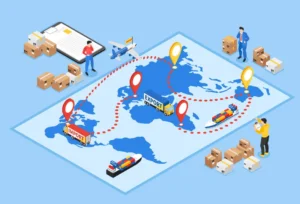You must be aware of the significant functional changes and new features of Dynamics 365 Business Central when comparing it with Dynamics NAV. D365 BC is the upgraded version of Nav. With NAV to Dynamics Business Central Upgrade, you can get a whole new set of advanced features. We will explore some key distinctions between Dynamics NAV and Dynamics 365 Business Central in this blog post.
40% of Business Central clients are in the United States, 12% are in the United Kingdom, and 6% are in Canada, according to enlyft.com. Small businesses make up 41% of all consumers, medium-sized businesses make up 44%, and large enterprises make up 14%.
For small and mid-sized organizations, Business Central is a cloud-based ERP solution that automates finance, sales, operations, and customer care to increase customer interactions, streamline business processes, and make smarter decisions. To take advantage of the improved features and capabilities that Dynamics 365 Business Central has to offer, many Fortune 500 organizations prefer NAV to Business Central Upgrade.
Difference Between Dynamics NAV and Dynamics 365 Business Central
Despite the many similarities between Microsoft Dynamics NAV and Microsoft Dynamics 365 Business Central, there are also significant distinctions that encourage many users to switch from NAV to Business Central
- While Dynamics NAV is an on-premises ERP solution, D365 Business Central is a cloud-based ERP solution.
- You may access your data and applications using Dynamics 365 Business Central from any location and on any device.
- While Dynamics NAV needs some customization and third-party add-ons to obtain the same degree of functionality, D365 Business Central comes with a comprehensive collection of features and functionality.
- While Dynamics NAV is licensed on a per-server basis, Business Central is licensed per user. When utilizing Dynamics NAV, you must pay for the server regardless of how many people are accessing the system, whereas, with Business Central, you only need to pay for the users who will be using the system.
Other major differences include:
User Interface
The user interface is where there are the biggest differences. With its simple navigation and cloud-based ERP solution design, Dynamics 365 Business Central increases efficiency. In contrast to Microsoft Dynamics NAV, which uses C/AL (Client Application Language), the new Business Central interface uses AL language code.
In Microsoft Dynamics 365 Business Central, the usage of AL language code allows for additional customization and aids in managing, upgrading, and creating extensions.
All the programs, including Office 365’s Outlook and Excel and Microsoft Dynamics 365 Sales, and Power BI Services are included in Microsoft Dynamics 365 Business Central (CRM). Automating processes avoid silos and raise productivity. End-users may build robust workflows and connectors without learning sophisticated coding.
Hosting
Dynamics 365 Business Central was first introduced to bring Dynamics NAV functionality to the cloud. Extensions and updates are significantly simpler to do with Microsoft Azure Cloud hosting. It makes it unnecessary for you to purchase and maintain your internal servers and allows you to expand or decrease capacity with a simple click. The main advantages of SaaS systems include improved security, lower risk of data loss, and better accessibility.
Upgrades
To prevent the systems from being out of date, important upgrades are automatically released twice a year. With constant enhancements, businesses are an optimal version of Business Central, unlike Microsoft Dynamics NAV. Updates enhance security and user experience. You can even delay it for 90 days. Users are forced to Upgrade NAV to Business Central by this function.
User License
The monthly subscription-based Microsoft Dynamics 365 Business Central software is offered in “Essentials” and “Premium”. Users can gain from usability on numerous platforms, Single Sign-On, iOS, Android, and PC. Remote work is convenient thanks to the cloud-based ERP solution, which also makes it incredibly flexible and affordable for enterprises. As opposed to Dynamics NAV, which comes in Starter and Extended Packs.
How Can You Move from NAV to Business Central
Dynamics NAV has been used by most businesses for years. Consequently, switching from NAV to Business Central update could be a little challenging. However, if users receive greater usability and more functionality than the NAV solution, it will be worthwhile.
It is challenging to transition Navision to contemporary platforms like Business Central because it is an extremely ancient program with a sophisticated code base. The transition is pricey, difficult, and time-consuming. However, there are several actions you must take if you want to get better over time.
NAV has been replaced by Business Central. Unlike the previous Navision, which required customization, it is a robust, adaptable application with capabilities that are ready to use. Although it costs money, it is the quickest way to pick up new skills and shorten the time to market. Any reputable and authorized Microsoft partner, such as Trident Information Systems, a gold partner of Microsoft, can sell Microsoft Dynamics 365 Business Central.
During the relocation, we will adopt the following procedures:
Step 1: Assessing your current NAV offering
Step2: Testing/Migration.
Step 3: Appropriate training and evaluation
Step 4: Properly start the migration
Step 5 is to keep supporting your company continuously.
If you are looking for a Business Central Upgrade Partner, you can Contact Trident Information Systems. We are a Gold Microsoft Partner and LS Retail Diamond Partner/ LS Central Diamond Partner.




